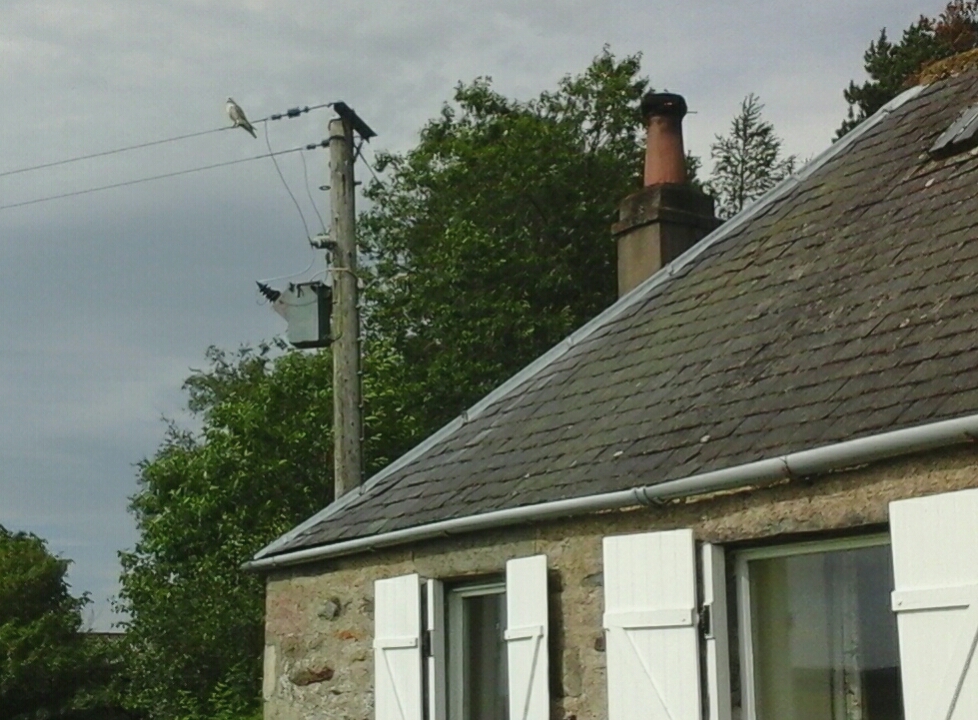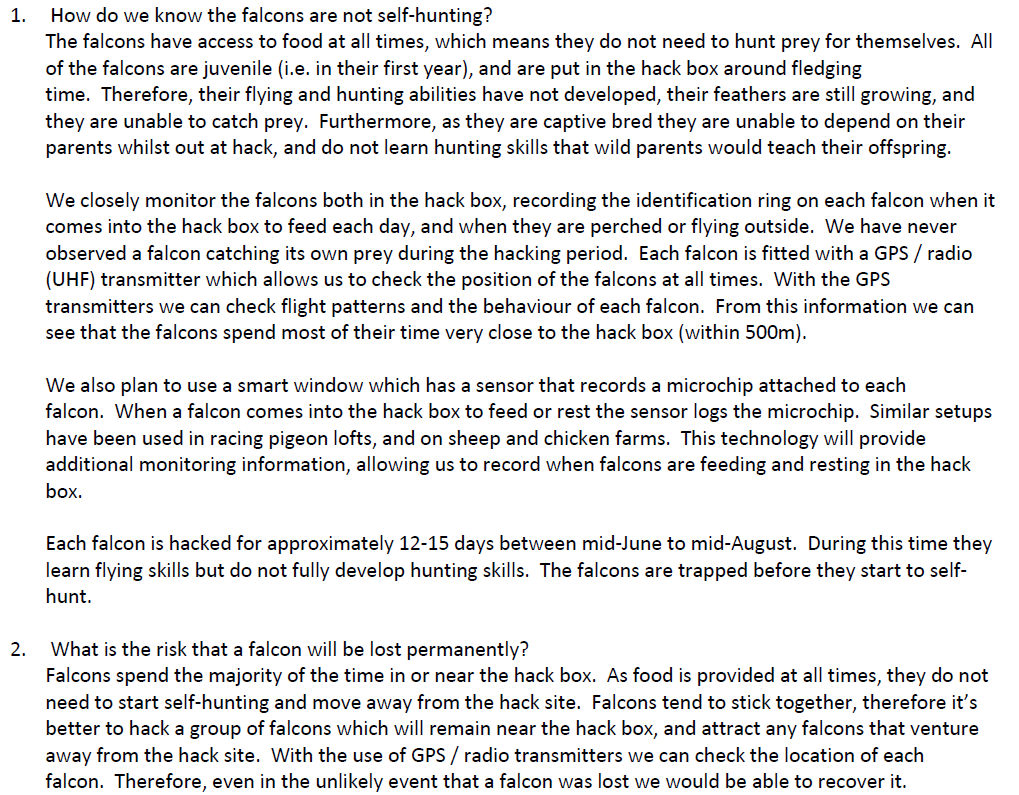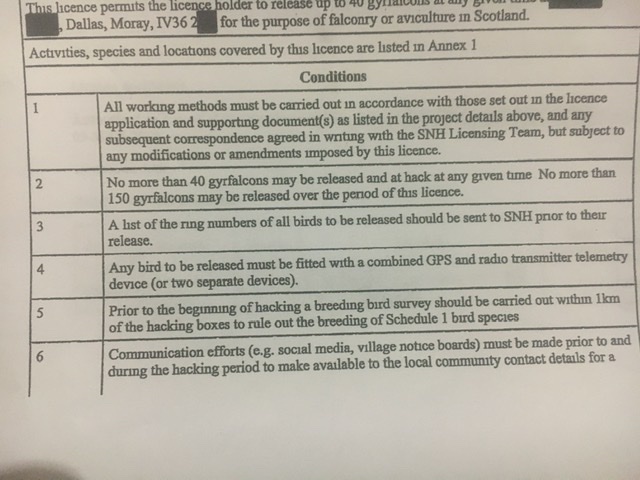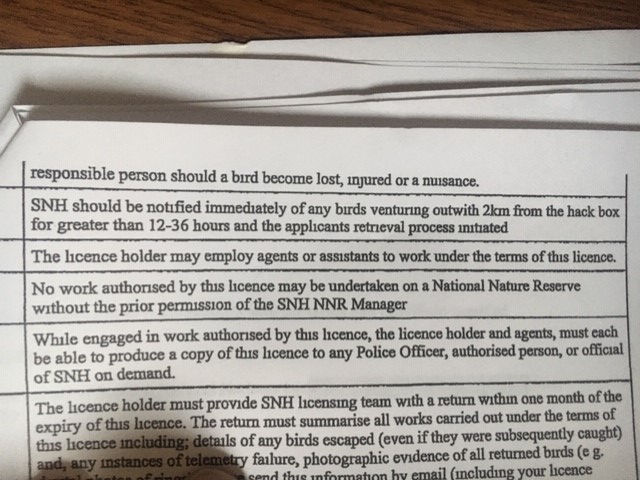
This post continues to explore the licensing of wild hacking of non-native falcons in the UK and uses information received from SNH about wild hacking licensed by them in Moray in 2019.
To catch up on the story enter wild hacking into the search facility on this blog (top right) and all posts on this subject will be listed.
To reiterate, I think that SNH have handled the licensing quite well, but not brilliantly. This is a novel issue for them to deal with, and I think they are finding their way with this subject. Personally, I believe that shining a light on the process can only help SNH to hone the process over time and ahead of considering any further licences for 2020.
On Monday I blogged about the general process and perhaps the most interesting finding to come out of the FOI response was that in at least 2018 (maybe earlier) wild hacking was carried out in Moray without a licence and it included hybrid falcons, the wild hacking of which is, according to SNH, illegal.
Yesterday, I blogged about the bird survey that was carried out as a condition of the licence but not as a prerequisite of the licence. The survey was of low quality in my opinion, and was carried out after the licence had been issued and the day before it came into force. The findings of the bird survey, such as they were, formed no part of the decision to issue a licence and so the utility of the bird survey was low.
I note in passing that if a proposal were to come forward to wild hack 150 large falcons on a grouse moor then the methods used at this site would almost certainly not have suggested any reason to hold back. The Red Grouse is not a Schedule 1 species and the chances of a Merlin nesting within 1km of any random point on most grouse moors would be low. And the chance of detecting anything in one visit would be low too.
Perhaps SNH should consider making the collection of specified bird and other biodiversity data next spring (say in April and early May), and its assessment by SNH, a precursor to issuing a further licence for wild hacking (say in late May but operative from mid June)? But I am probably getting ahead of myself there…
Today’s blog is about the evidence that falcons left the hacking area – and went far beyond the very restricted area in which bird data were (rather casually) collected.
Let me summarise what you will read in this rest of this blog post. First, I will quote from correspondence between the licensee and SNH which form part of the exchange of information running up to and including the licence application. This information could be summarised as ‘the falcons at hack don’t go far (usually) and don’t catch their own wild prey, so don’t worry’. Then I will quote from the licence and its conditions issued by SNH and then quote from the information received by SNH at the end of the wild hacking season and after last summer’s licence expired.
- The case for the licence:
This passage, which I published on Monday, says that the falcons have never been seen catching wild prey whilst at hack (I don’t know whether there are any such reports from local residents) and are returned to captivity before they self-hunt. Food is provided at the wild hacking site to discourage the birds from hunting wild prey and from wandering away from the site. The falcons spend most of their time very close to the hacking site and are returned to captivity after a couple of weeks.

Here is a similar passage from correspondence between the licensee and SNH which introduces the term ‘tame hacking’ which is quite clever (and amusing) and which further makes the case that the birds don’t go wandering off;

2. The licence
Condition 4 of the licence says that the birds must be tracked;

and condition 7 says that absences from a 2km radius of the hack box of over 12-36 hours (is that over 12 hours or over 36 hours?) must be reported immediately to SNH;

3. What happened in practice
This was received in the FOI response.

All 122 Gyrs which were wild hacked were recovered (alive or dead) so it is important to note that there were no permanent escapes into the wild. Good!
But seven birds did leave the area within 2km of the hacking box for more than 12 hours (as in the table above).
Note added on 20 December: : I have amended the original post in response to information received after receiving clarification from the licensee via SNH. All the original text is still present so that you can see what I wrote. The text that needs changing is struck through (like this) (and two whole paragraphs are given a red background). This paragraph and another new paragraph have been added with grey backgrounds. SNH has apologised for any confusion and so do I and I’m happy to correct these points.
My interpretation of the table is that Column 2 (Date in) refers to when the birds were put in the hacking area. Column 3 (Date out) gives the date on which each of these seven birds left the hacking site – ie had spent more than 12 hours further than 2km from the site. Column 4 (Days out) seems to give the period of time the birds were away (>2km?) from the hacking site. Column 5 (Capture date) is when the bird was taken back into captivity. Column 1 is when SNH was notified of the birds’ absences being over 12 hours. There may be other interpretations of these column headings but that’s what I think they mean (and I have emailed SNH to check).
If my interpretation is correct then condition 7 of the licence was broken several times as SNH was told of the absences long after they started (not immediately) and usually when the bird was recovered. That wasn’t, to my understanding, what the licence stipulated. I’m not sure this is very serious of itself, but, just saying…
Column 1 is the date when SNH was informed that a bird had travelled more than 2km from the hack site for more than 12 hours. Column 2 is the date when the birds were out on hack. Column 3 is the date when the falcons first flew outside the hack cage. Column 4 is the number of days that the birds were out on hack and Column 5 is the capture date. And so the number of days for which birds were more than 2km from the hacking box is Column 5 minus Column 1 – usually a matter of just a day or two or three. That does put a different complexion on things and it does appear that the birds are quickly recaptured back at the hack box after they have strayed.
Given that the information provided in, and running up to, the licence application gave the impression that the birds would not leave the area and would not self hunt these few exceptions to the first of those situations are significant. And once the birds are over 2km away from the hacking site then we know very little of their behaviour or their impacts on native fauna (and the bird survey undertaken provides no useful information).
Some birds appear to have spent weeks DAYS away from the hacking site – although the information provided is a bit unclear. Who knows what a Gyr is doing when away from the hacking site for weeks?
It will be very interesting to see where the birds have gone (or at least how far away from the release site) during the period when they are absent. SNH has said that they are analysing these data and will provide them in due course. We will await that information with great interest.
I think that the information revealed in this post suggests that the assurances given by the licence application and preceding correspondence were on the, shall we say, optimistic end of things. Some birds left the hacking area and we do not know yet how far they roamed but it appears that they roamed for long periods of time (and for much longer than SNH was told that birds would be at hack). The bird survey carried out to assess impacts of large numbers of non-native falcons being released was of limited value in any case, but with this information (not yet complete) on the birds’ behaviour then it is shown to be of very little value at all.
Mark
I’m not an expert, but I think that the location data that SNH are withholding (which they call KLM files) are really kml files. If so, that’s just the format used for plotting locations on Google Earth and you (or maybe some tech-savvier chum) could immediately plot the maps of where the birds have been. So you might want to take up their offer of having the “raw data” to look at.
I am curious to find out what they mean by “staying near the hack box”. They spend alot of time flying at the bottom of the glen and totally out of sight from that hack box. Neighbours gardens in all directions are not visible from the hack box. They cannot possibly monitor all 40 falcons and their behaviour. The details of this year’s telemetry is vital but still tells us nothing of what they are up to when flying away and out of sight, no one will ever know that. They become bold very quickly and when they feel like it they and can cover a km of ground in 30 seconds.
Is nobody watching falcons? That sounds unbelievable!
How do you mean by the falcons become bold?
I’m seeing the same claims being repeatedly made about the destruction these falcons create and then in the next comment just suggestive mentioning that the falcons are up to mysterious activities.
I don’t know if anyone saw my previous comment but it would be fascinating to see some photos of the damage and disruption caused, is there anywhere I can find this?
Ireland Rose….I would suggest that bold means dive bombing people, pets and birds. Not frightened at all. This is not what is portrayed by the falconers though. Can they prove this doesn’t happen? The onus is not on us to prove anything.
This summer I saw a red kite being chased away, in the morning and evening, by six falcons. I watched from my garden. A few were smaller and could have been Peregrine. They chased it several km’s south east. The red kite has more right than captive bred falcons to be here and we do not want them chased from their territory. I also witnessed two falcons take out a crow, it dropped like a stone. We are not photographers, although I do have a few photos. I am sure a professional photographer would love it.
No one as far as I am aware mentioned the word destruction. Harassment and disturbance yes.
Hi Trudi
Perhaps my understanding of Onus is wrong but I will use an analogy to explain my point – I would guess the falconers would say that the falcons do not attack people, I claim I have been attacked by falcons – in this situation is it for me to prove that I have been attacked or for the falconers to prove that I wasn’t? What evidence would suffice that the falconers could provide?
I’ve read about wildlife being killed, abandoned nests/eggs and even a recovered Buzzard, non require a photographer rather any device capable of taking a photo. I might be wrong but after living with 2(?) years of hacking and the dire consequences of such, I’ve seen nothing to substantiate any of the commenters claims apart from there are falcons at hack.
Firstly, can anybody let us know what exactly tame hunting is?
Secondly, falcons may not be self hunting while ‘under control’, but they are certainly harassing, if not attacking: We were sitting outside last year (2018) in summer with a visiting friend, watching a buzzard flying above us. A big white falcon appeared from behind it and swooped down on the buzzard. Obviously there was physical contact because we saw feathers flying. The white falcon did not kill the buzzard, but what would you call the incident other than an attack? Is it important whether they hunt or whether they harass/attack? Six half a dozen to me.
Finding the whole idea novel and wierd but I have a thought about the birds not taking wild prey because they are fed by their ‘captor?’, is that the right word?
We might well raise a quizzical eyebrow to this statement, However we have tried to convince the tweed lot that diversionary feeding works to the extent that no grouse chicks were taken by harriers.
Just think we need to be consistent?
Bimbling – well it’s not aq great analogy, I think. We haven’t tried to convince them – we have carried out trials and demonstrated that diversionary feeding works. We didn’t just say it would. But here the onus is on the falconers to demonstrate that feeding does work. the condition imposed by SNH to track the movements of the birds will show whether or not this is true.
Fair enough.
Still trying to recover from the shocking sight of my spelling of the word weird!!
Its a shocker.
Second document posted above: The licensees do not consider the falcons outwith their control.
I don’t think that their reply actually answers the ‘control’ issue. Apart from the fact that the telemetry devices can get lost (a neighbour found one in his garden, no bird attached. Bird lost?), the devices don’t have a recall button.
What would you call a falcon which dive bombs people, pets and buzzards? Under control?
During the hacking season of 2018, we found a large white and speckled grey falcon, dead on our property, beneath the electricity lines into our garden, within 5 metres of our house. It was NOT wearing a transmitter, just an ankle ring. There was no transmitter anywhere around that might have become dislodged.
A trip was made to the breeding establishment from where these birds were being flown and the proprietors there had no knowledge about any missing bird. Their response was that the birds fly off, sometimes for two or three days, before coming back.
Question: Don’t these birds eat for two or three days at a time?
They did come and fetch the bird though.
The licencee seems to have only given three flight pattern examples submitted from 2018. Two birds ranged outwith 2km’s. One approx 7km, another 20km’s to Grantown. This summer 2019, 7 birds have been reported outside the 2km zone. Only one of these had any detail and this individual flew 20km to the RSPB reserve at Culbin sands. There seems to be no details of where the others were recovered.
SNH had previously requested 80 GPS returns (only Gyrs) from 2018 and then a further 122 (Gyr) from 2019. Has SNH managed to analyse the data for the 202 tagged Gyrs in order to build up and a clear picture of the birds ranging behaviour on both a daily and any extended time. Did they analyse the 80 that were requested in 2018 before this licence was issued.
[Posted by Mark on behalf of Anand Prasad who is still ahving problems posting cvomments]
Change the meaning of the word hack should work well in this post facts world.
Hacking has one purpose, allowing raptors to learn to kill.
That bird which was ‘out’ for 27 days and found dead looks like an escape to me and birds which were out for 24×2, and 26 look suspiciously like self hunting birds. We don’t know exactly the details of these birds, does SNH? Were they healthy or emaciated when they returned or did they return to the hack box to feed. Why were 3 birds dead? It looks like they were not returning to the hack box to feed and may have starved.
This doesn’t really make much difference to me but if the applicants are making one false statement i doubt they can be relied on regarding the lack of hybrids especially when their application suddenly dropped the hybrid application.
Sooner or later there will be an escape.
I find SNH to be incompetent and gullible, as usual.
They won’t declare new SSSIs because they can’t protect them yet they release licenses like this which they also know they haven’t the
resources to monitor.
I would rather have more SSSIs.
I agree with all Anand Prasad has said above. For anyone to claim that any of these birds are under any kind of ‘control’ when they leave the ‘box’ is disingenuous, if not downright dishonest.
It seems to me that the only ‘control’ the licensee has over these falcons is the (apparent) fact that they know where the birds are. Given that a dead bird was apparently found without a harness makes me suspicious of this claim too!
It strikes me that this is a classic case of an individual, or individuals, out to make a whole lot of dosh with scant regard for either the local wildlife or the people who live there. Where, I wonder, have I heard that before!
Get your fingers out SNH and deal with this properly!
Full breeding bird survey to at least 5km out by persons employed/contracted by SNH, paid for by Licensee.
Maximum of 10 birds permitted out at any one time – even this is excessive.
Full vetinary examination of each bird to be hacked by competent person prior to release (to ensure no hybrids are going out to hack). Employed/contracted by SNH, paid for by Licensee.
DAILY data to be uploaded by Licensee to SNH showing movement of birds in the preceding 24 hours. Failure to upload information results in immediate revocation of Licence. SNH to make public that data within 24 hours of receiving it – no big deal!
This is all kids stuff! How someone in SNH, probably with a degree or two, could even have considered allowing 40 or so Gyr Falcons – top predators – to be released at the same time, in a very small area, beggars belief!
Please tell me how this differs from 200-300 red kites held artificially within a small feeding station area?
Purely regarding effects on local wildlife, the Kites possibly have
a greater impact, but of course they are native.
ummm….. red kite is a NATIVE species (previously eliminated by people and persecution)/ now (NATIVE species) reintroduction – according to IUCN guidelines etc.?? I don’t think red kites are ‘held’? – `and presumably feeding stations only a temporary solution (and/ or for education/ demonstration so people can see them and understand what NATIVE spp reintroduction means?). No comparison with gyrs and hacking??
PLEASE NOTE NEW OPENING TIMES FOR 2019
We open every day even Christmas Day and New Years Day
1st January to December 31st 12pm to 4pm
Admission £5 per adult children under 16 free
Feeding is at 2pm every day
Dogs are welcome as long as they are kept on a lead
Taken from red kite feeding station website. Temporary- no, pocket filling – yes.
Hecla: Agree with everything you say.
Andy: Thanks for the analysis, very interesting.
Question to SNH: 7 falcons were away between 6 and 27 days. Were you ‘immediately notified’ once they were gone longer than 36 hours as per your licence condition?